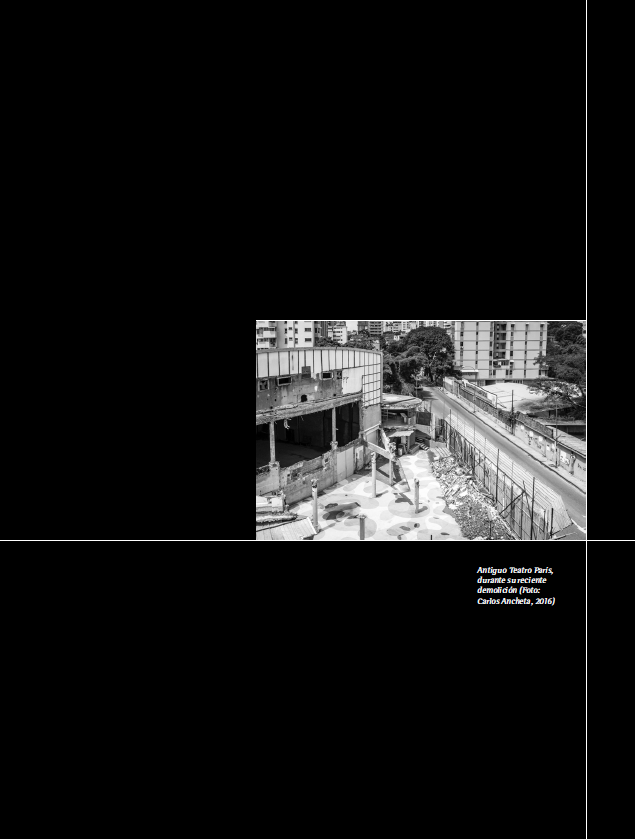The Architecture of the Caracas cinemas: 1925-1960. Five cases
##plugins.themes.bootstrap3.article.details##
This article deals with emergence, development and decline of movie theater architecture in Caracas from 1925, when the first building specifically created for that use was erected, to 1960, year when the last of these “movie palaces” opened its doors. Over the course of these five decades, the cinema building underpinned the modernity of the growing city, attentive to the trends of its time. Since then, the cinema function has taken refuge in the interior of the large malls that have multiplied in Caracas, as a substitute of open-air public space. This process has implied the progressive closing of the old movie theaters, whose buildings have carelessly been demolished, abandoned or transformed into other uses that completely distort their architecture and their once life-giving presence in the urban fabric.
architecture, cinema theater, public spaces, facades, neighborhoodsarquitectura, salas de cine, espacio público, fachadas, barriosarchitecture, patrimoine, salles de cinéma, espace public, façades, quartiers
Amendola, G. (2000). La ciudad postmoderna. Madrid: Celeste Ediciones.
Barrios, G. (1992). Inventario del Olvido. Caracas: Fundación Cinemateca Nacional.
Cebollada, P. & Santa Eulalia, M. G. (2000). Madrid y el cine. Madrid: Comunidad de Madrid.
De Sola, R. (1988). Reurbanización El Silencio. Crónica. Caracas: Fundación Villanueva e Instituto Nacional de la Vivienda, INAVI.
Friedberg, A. (2006). Window Shopping. Cinema and the Post Modern. Berkeley: University of California Press.
Jacobs, J. (1961). The Death and Life of Great American Cities, New York: Random House.
Moholy-Nagy, S. (1964). Carlos Raúl Villanueva and the Architecture of Venezuela. Caracas: Lectura.
García, M. y P. Méndez. (2014). “Abstracciones de película. La arquitectura moderna de los cines argentinos, 1925-1950”, en Gazzaneo, L.M. (ed.). Artes & Territorio en el mundo lusófono e hispánico. Rio de Janeiro: Uni¬versidade Federal de Rio de Janeiro
Naylor, D. (1991). American Picture Palaces: The Architecture of Fantasy. New Jersey: Prentice Hall Editions.
Ponti, G. (1954). Coraggio del Venezuela. Domus, (295), 1-7.
Pérez Rojas, F. J. (1986). El cinematógrafo en Madrid, 1896-1960. Los cines madrileños: del barracón al rascacielos. Madrid: Museo Municipal.
Ramos, A. M. (2006). Lo Urbano en 20 autores contemporáneos. Barcelona: Ediciones UPC.
Sánchez Fernández, D. M. (1977). Cines de barrio. Madrid: Ediciones de la Librería.
Sidorkovs, N. (1994). Los cines de Caracas en el tiempo de los cines. Caracas: Armitano Editores.
Sueiro, Y. (2008) Escaramuzas cinematográ¬ficas Primeras salas de cine en Caracas, Venezuela (1896-1920). Recuperado el 12 de febrero de http://cinematv.mforos. com/296110/2290491-primeras-salas-de-cine-en-caracas-venezuela-1896-1920/
Torres, A. (ed.). (2015). Fervor de Caracas. Una antología literaria de la ciudad. Caracas: Fundavag Ediciones.
VV. AA (2009). Guía básica de arquitectura de Madrid. Madrid: COAM.
Vicente Garrido, H. (2011). La ficticia ‘ilusión’ del destierro. Arquitextos Vitrivius, 128(04).


